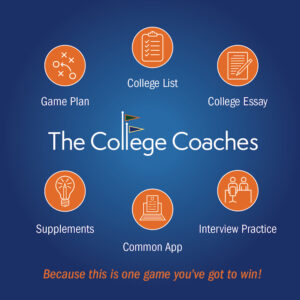This is a guest post from Kathleen Glynn-Sparrow and Greg Schneider of The College Coaches.
If you like this content and want more like it, feel free to join our free workshop in June! Register here: Testing, Timeline and Trends: What You Need to Know About the Changing College Admissions Landscape.
Leave the Legwarmers and Bomber Jackets in the ‘80s: Update Your View–and Your Look–for College Counseling in 2022
It was the ‘80s. You were strutting through the high school hallways with your big hair and neon leg warmers or your mullet and bomber jacket. Or maybe it was the ‘90s, and you were rockin’ the grunge vibe with your too-cool-to-care flannel and Dr. Martens. No matter the decade, there you were as a teen thinking deeply about what you were looking for in a college.
Yeah, right.
So, why is it then that we parents expect our students to be seriously considering college prospects, or even majors, when that was the furthest thing from our minds in those glory days?
It’s simple: we want what is best for our kids. We have given them our love, time, and of course, money, so we are “invested” in them. Now we want to make sure they make a good decision about where to go to college and that we as parents can afford to send them to that college because let’s just say it: college is a very pricey investment.
College Research: Where to Start
How to begin? Slowly.
Why?
If you as a parent come off as a steamroller at the start of this process, your teen will revert to the proverbial–and dreaded–responses to all of your college questions with “Fine,” “I don’t know,” or “Whatever.”
Give them the grace and space to, well, “process” the college process. It’s a lot. They just mastered finding their locker (and opening it!), navigating the tricky high school social scene, putting themselves out there for sports and plays, and getting decent grades.
And society is essentially saying, “Good job with all that! Now that your life is basically on track to avoid Euphoria, let’s pummel you with questions about your future!”
Yet the college process is looming, and you cannot wait for your student to be “ready” to spend hours with you talking about college. So, here’s an easy and hopefully fun way to start. Ask your teen to start with something easy, like using Tik-Tok or YouTube, to find some answers to these questions:
- Major: Do you have specific interests for college study (i.e., business, biology, cybersecurity, video game playing…kidding, that’s not a major…but video game design is, so there really is something for everyone!)? If you are unsure, no worries! Maybe don’t mention there are plenty of core classes that first year.
- Size: How many students? More than your high school because you are tired of all those people?! Keep in mind that bigger schools have bigger class sizes–will you get lost in the crowd, or are you a self-advocate?
- Location: Do you want to be near ski slopes or the beach? Answer: It does not matter because you will be studying…right? Do you prefer an urban or rural campus? Do you prefer a liberal arts or technology university?
- Distance: How far is too far away to go to college? How close is too close? Students and parents may have different responses to this question!
- Support: Would you benefit from a weekly check-in with an academic advisor?
Size Of Your College List
Okay, now you have a start. So, how many schools should you aim to have on the list? Back in the day, you probably applied to 3 or 4 schools and were done. No one even bothered to categorize schools as “reach,” “target,” or “likely.”
Nowadays, no one uses “safety” anymore because that implies guaranteed admission.
In today’s more competitive college landscape, it is wise to apply to 8 to 12 colleges. The breakdown should be roughly as follows: at least two likely schools, two to four reach schools, and the remainder target schools.
Use your school’s college counseling software, such as Naviance, SCOIR, or Cialfo, to see how students from your high school with a similar profile have fared at these colleges over the past few years.
Consider Financial Feasibility
Another reason to have a balanced list is to leverage merit aid. Average merit aid awards are usually available to anyone. Use this data to determine which colleges are generous with merit aid. (Hint: Not Ivy League universities!)
Some colleges do not barter; others do. At the end of the process, after acceptances are in, whoever is the best negotiator in the family can call or email the top choice college and say, “My student wants to attend your university, but this other university gave this much in merit aid. Is there any way you can match it?” The answer will either be “No,” and you lost thirty minutes of your time; or the answer could be “Yes,” and you just found several thousand dollars!
Some state schools will also offer in-state tuition rates to academically strong out-of-state students to encourage them to attend.
Most schools do not offer financial incentives to Early Decision applicants because they know you are hooked. Plus, if you apply ED, that takes the bartering option off the table. So, if you are looking to leverage, make sure that you have a good number of target and likely schools on your list that are known for generous merit aid.
What’s In a Name?
It is understandable to be lured by a prestigious college name to put on your car or to brag about at holiday parties, but it is more important to consider if your student would be happy at that college.
What is the point of paying a ridiculous amount of money for your student to attend a well-known college if it’s not a good fit? Go back and reread Donna Tartt’s The Secret History, if you’re still not sure.
Here’s a good rule of thumb: when you are visiting “highly-rejective” colleges ( the new descriptor for “highly-selective”), include some nearby, lesser-known colleges. You just might be surprised.
Even better, read about the transformative colleges in Loren Pope’s Colleges That Change Lives; and revisit the power, or lack thereof, of prestige in Frank Bruni’s Where You Go Is Not Who You’ll Be.
Bottom Line: Be a Helpful Guide, But Don’t Make the Decision for Your Child
Your student will get accepted to colleges. There will undoubtedly be some surprises–some good, some not-so-good–but your child will have choices if they create a balanced list using their own college criteria–note your student’s criteria, not yours.
Your role in this process is to support and encourage your student–and of course, to make them suffer through your heyday stories and photos of you rockin’ your high school look!
Authors:
Kathleen Glynn-Sparrow and Greg Schneider of The College Coaches
For additional present-day advice from The College Coaches, book time with us here, or explore more with a 15-minute free introduction here.
Further resources:
Testing, Timeline and Trends: What You Need to Know About the Changing College Admissions Landscape


